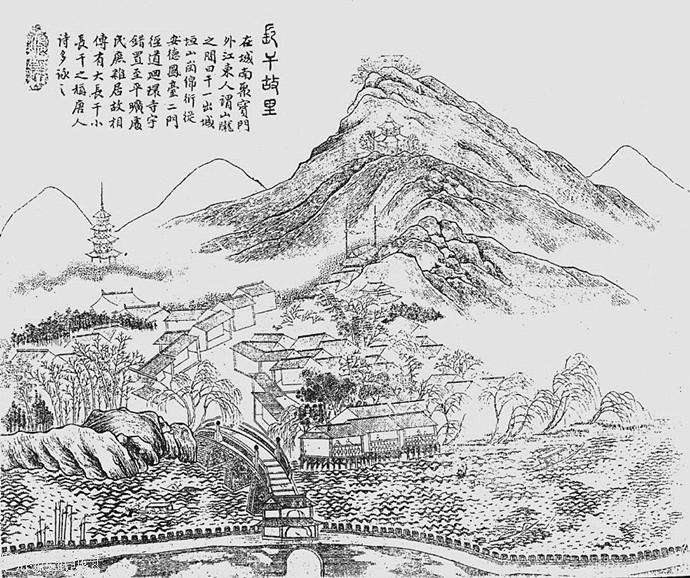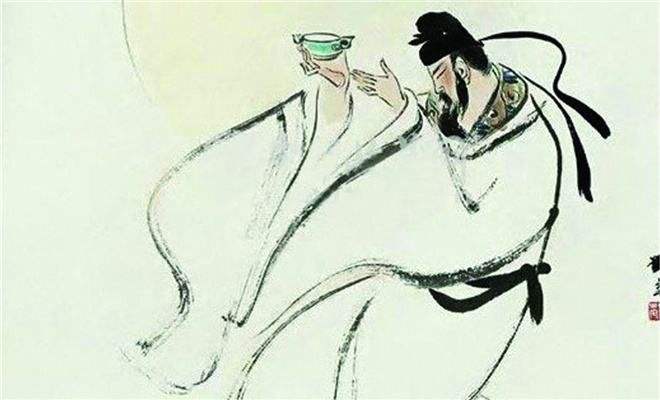How many ancient place names are hidden in Li Bai's poems
Author:Intersection Time:2022.07.29
Text/Yao Shunzhong
Nanjing, known as Jinling in the ancient times, known as "Zhongshan Dragon, Shicheng Tiger, Emperor's House". The literati and writers of all ages fell in love with the Jinling -shaped victory, leaving many poems and songs that sang Jinling, so that Jinling shines in the historical river of Chinese literature.
Li Bai, Shixian in the Tang Dynasty, had a soft spot for Jinling. He left a total of more than 1,000 poems in his life. Among them, more than 50 songs chanted the golden belt or related to Jinling. Some, some still have traces to follow.
Long Ganli
Chang Qianxing, and also made a long -working song. It was the name of Lefang's "Miscellaneous Songs". It was originally a folk song for the lower reaches of the Yangtze River. There are Changganli in Nanjing, that is, the south bank of the Qinhuaihe River to Yuhuatai to Xiaqianqiao.

Changganli painted by people in the Qing Dynasty
As early as the Qin, Han, and Six Dynasties, Nanjing Changgan was the most prosperous place. "Jiankang Records" contains, Nanjing has large and long -dry, small long dry, and east -growing dry, and is named in the ground. Xiao Changgan, in the south lane of Waiguan, came out of the river. Many Changgan people take the boat as the home and dealer as the industry, so that Changganli has become a well -known business district and cargo distribution center in the country. The poet Li Bai came from the Yangtze River to the Changganli ashore. Perhaps such a business downtown, perhaps the sorrow of a beautiful woman bowed her head, and immediately stirred the endless reverie of the poet. "It was born like this.
There are two songs in "Chang Qianxing". One of them wrote: "Lang rides bamboo horse, and makes green plums around the bed. Living together Changgan, two small guessing." The two idioms of "green plum bamboo horses" and "two little guessing" later generations. The second wrote: "Recalling the deep girlfriend, smoke and dust are never known. Marrying and a long -working person, Shatou waited for the wind." Hidden love in a faint grievance, expressing it vividly.
Phoenix
Fenghuangtai mentioned many times in Li Bai's poems that this is a very eye -catching place name. Li Bai has poems such as "Deng Jinling Phoenix" and "Jinling Phoenix Terrace", which is enough to prove that the Phoenix Terrace of that year is where Li Bai often comes to meet with friends.
"Deng Jinling Phoenix Terrace" is included in 180 volumes of "Quan Tang Poems", which is one of the few seven -character poems in Li Bai's poems. Li Bai and this poem have a beautiful legend. It is said that Li Bai went out to sword from Shu for a long time. When he arrived in Hubei to board the Yellow Crane Tower for the first time, the poem should have become very popular. Poetry is above. " Ascending Phoenix Terrace, facing the Yangtze River in front of him, in the Yellow Crane Tower's pooled oil, but Li Bai and Cui Yiyun wrote "Deng Jinling Phoenix": "Phoenix Tour on the Phoenix Terrace, Phoenix went to Taiwan The empty rivers are self -flowing. Wu Gong flowers and grass are buried in a trail, and the Jin Dynasty clothes are crowned into ancient hills. Three mountains and half of the sky are divided into eggiezhou. Floating clouds can cover the sun, Chang'an does not see people. "Li Bai's" Deng Jinling Phoenix Phoenix Phoenix " "Tai", with Cui Yan's "Yellow Crane Tower", should be described as the double stories of writing scenery in the history of Chinese literature.
"Jinling Phoenix Terrace" and "Deng Jinling Phoenix Terrace" are sisters. Was the two poems written in the same time as Denghuangtai. There is no exact evidence, but from the perspective of poetry content and expression, the two poems are separated from each other. The time of time is not long, they all express the loss of the loss after leaving Chang'an and the helplessness of the country, and the idea of timely and fun in "Jinling Phoenix Terrace" is more negative. "Setting the wine to extend the scene, Jinling Phoenix Terrace. Long waves are written in all ages, and the heart and the clouds are open." The poem first explained the time and place of the wine, and the "scene" refers to the glory of the sunset, indicating that the time for the wine is in the evening. We can imagine that on the Phoenix platform of Jinling, facing the big river, the sunset west, three or five confidants, and drinking and drinking, it is so pleasant.
Chengxi Tower and Sun Chulou
"Quan Tang Poems" Volume 178 contains Li Bai "Playing the Moon Jinling City West Sun Chu Restaurant, Da Shi Ge Blows, drunk day and night, wore Ziqi Qiu, black scarf, and sang Qin Huai with several wine guests. "Shi Yu", the title of this poem is 42 words, which is the longest topic in Li Bai's poems. We don't need to read the content of the poem, so we can see that Li Bai is really crazy in Nanjing City. He drinks the moon and play the piano in the Sun Chu restaurant, played the piano, played overnight, and was drunk in the evening. Suddenly Remember to visit Cui Zongzhi.

Sun Chu Restaurant Picture Source: Visual China
Sun Chulou, it is said that Sun Chu, a poet in the Western Jin Dynasty, came here to be named and chanted. There are records that Sun Chulou is on the northwest of Jinling City on the hills. Jiuhua Mountain was once called Cingzhou Mountain. If Sun Chulou is in Jiuhua Mountain, the current Jiuhua Mountain is in the north of Nanjing City, then the "west of the city" is a bit sorry. In addition, the stone city is in the cool mountain. In the west of the city, Li Bai is drunk to find Cui Zongzhi, and everyone responds, indicating that Sun Chu's restaurant should not be far from Shiti City. So there are two questions here. One is that Sun Chulou is not overwhelming? The second is whether Sun Chulou and Sun Chu restaurant are the same? It is likely that the restaurant's restaurant name is "Sun Chu Restaurant".
Li Bai also has a poem "Jinling City West Tower Moon", which contains 166 volumes of "The Poems of the Tang Dynasty". This is a widely circulated poem. It has also been selected into various textbooks. Essence The annotation of various versions of "City West Tower" is "Sun Chulou". This explanation is likely to be affected by the words "Playing the Moon Jinling City West Sun Chu Restaurant". It is believed that the west building of the city is Sun Chulou. However, from the content of the poem "Jie Dao Chengjiang Jing Ruyan, it makes people remember Xie Xuanhui", this "city west building" is indeed a good place to observe the scenery.
New pavilion
Li Bai's "Jinling New Pavilion" contains 185 volumes of "Poetry of the Tang Dynasty". The poem opened the door to see: "Jinling has good scenery, and the princes are new pavilion." "New Pavilion" is also known as ZTE. City South. There are many allusions about the new pavilion in history. After the death of the Western Jin Dynasty, he fled from Central Plains to Jiangnan's giants and princes. In the "Speaking of New Words, Words", a group of priests in the Eastern Jin Dynasty gathered in the new pavilion. This is the allusion of "New Pavilion to Weep". Zhou Hou is Zhou Yan, who is "partial hurts Zhou Yanqing" in Li Bai's verse. "It is also his allusions.
Xinting is close to the Yangtze River. It was an important military fortress during the Six Dynasties. Xinting Linjiang is in danger, and the scenery is peculiar. It is a famous scene. Xu Song in the Tang Dynasty recorded that the first beautiful man, Wei Yan, was buried in the east of Xinting after being "watched". New Pavilion, ancient temples. According to "The Temple of the Southern Dynasties", the Emperor Jin Xiaowu Emperor Taiyuan Li Xinting Temple, Emperor Xiaowu of Song Xiaowu changed to ZTE Temple, and the Emperor Song and Ming Dynasty was renamed Tianan Temple. Over time, these buildings in Xinting have long disappeared, but its figure can still be found in Xinting Street and Xinting Park in Nanjing.
Laosu Pavilion
Li Bai has two poems about Laotu Pavilion, namely "Lao Lao Pavilion" and "Lao Lao Pavilion". The creation time of "Lao Lao Pavilion", the author tends to be made by Li Bai in his later years, because the content of the poetry is mainly to hurt the other. "The world is sad, and the labor and labor pavilion is sent.
The ancients had the habit of folding Liu to send guests, so the poet used anthropomorphic methods to say that the spring breeze knows parting and suffering. Except for a bitter word, there is no other meaning in the whole poem. The same is true of "Lao Lao Pavilion": "Jinling Laowan sent the guest hall, and the grass is separated from the biological road. The ancient feelings are not all flowing.
Laotu Pavilion, also known as Lao Tower, Laosha, Wangyuan Tower, Wangyuan Pavilion, Yuanwanglou, Lincang View, "Cihai "'s description of" Laosha Pavilion "is as follows:" Laosha Pavilion in Nanjing, Jiangsu today The city of ancient new pavilions; the old saying is the new pavilion, and the mistake.

"Labor and labor", the "raising hands and labor" in "Peacock Flying Southeast". The context of this poem is farewell, and later "Labor" became the farewell of the ancients. There are many historical classics in Laosha Pavilion's specific location. That is its place. "Jiangnan Tongzhi" contains: Lao Lao Pavilion, southwest of Jiangning Prefecture.
- END -
Roland Bart's drama symbolism explanation
The constructing of drama symbolics and the construction of the body theater is still worthy of in -depth thinking that we are worthy of our combination of the development history and the characterist
Recommended reading | Big brother is a soldier

—— 村.” Series of twenty -ninth series□ Li DonghongIn the afternoon, I haven't...